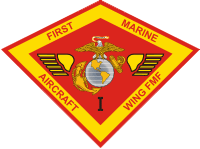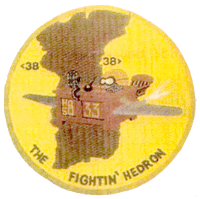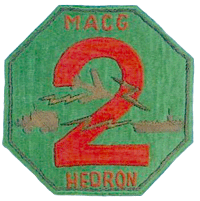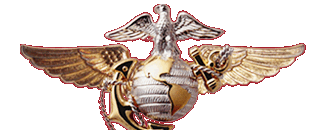MCARA Units >1st MAW MACG-2 AEW/ECM Section (Korea 1952)
Also See:
1st Marine Aircraft Wing Headquarters Squadron (HEDRON-1) and MACG-2 AEW/ECM Section History
The following information is attributed to the written personal history of the origins of Marine Corps Electronic Counter Measures (ECM) by Major Daniel C. Georgia.
 The 1st MAW ECM section was formed in July, 1951 with the arrival of Msgts. Joe Bouher and Doc Grimes from 2nd MAW Hedron-2’s AEW/ECM section, which was the first known ECM capable unit in the Marine Corps. These two pioneers of USMC ECM brought with them two radar jamming transmitters they had modified at Cherry Point based on a report of the North Koreans employing radar controlled AAA operating in the 1000 megahertz range.
The 1st MAW ECM section was formed in July, 1951 with the arrival of Msgts. Joe Bouher and Doc Grimes from 2nd MAW Hedron-2’s AEW/ECM section, which was the first known ECM capable unit in the Marine Corps. These two pioneers of USMC ECM brought with them two radar jamming transmitters they had modified at Cherry Point based on a report of the North Koreans employing radar controlled AAA operating in the 1000 megahertz range.
 The newly formed ECM section was under 1st MAW HEDRON -1, although it first employed two AD-2Q Skyraider aircraft that were assigned to HEDRON-33, MAG-33 at K-3 airfield in Pohang, South Korea. The AD-2Q was a 2 place aircraft (pilot & ECM operator) that had entered service with the Nayy in the 1948 timeframe. The ECM suite consisted of a AN/APR-4 receiving system and AN/APA-11 signal analyzer essentially the same equipment utilized in the TBM-3Q Avengers at MCAS Cherry Point. The two AD-2Qs did not have a direction finding capability but Bouher and Grimes obtained two AN/APA-17 direction finders which they installed in the aircraft. . The jammers they had brought over apparently were never employed as the focus of these early ECM efforts was to intercept, classifiy and locate enemy radars. The modified AD-2Q aircraft with its direction finders gave the Marine Corps the only real ECM capability operating from a Korean base and perhaps in theater as it is not clear if the Navy’s aircraft carrier-based ECM aircraft had that capability.
The newly formed ECM section was under 1st MAW HEDRON -1, although it first employed two AD-2Q Skyraider aircraft that were assigned to HEDRON-33, MAG-33 at K-3 airfield in Pohang, South Korea. The AD-2Q was a 2 place aircraft (pilot & ECM operator) that had entered service with the Nayy in the 1948 timeframe. The ECM suite consisted of a AN/APR-4 receiving system and AN/APA-11 signal analyzer essentially the same equipment utilized in the TBM-3Q Avengers at MCAS Cherry Point. The two AD-2Qs did not have a direction finding capability but Bouher and Grimes obtained two AN/APA-17 direction finders which they installed in the aircraft. . The jammers they had brought over apparently were never employed as the focus of these early ECM efforts was to intercept, classifiy and locate enemy radars. The modified AD-2Q aircraft with its direction finders gave the Marine Corps the only real ECM capability operating from a Korean base and perhaps in theater as it is not clear if the Navy’s aircraft carrier-based ECM aircraft had that capability.
 In February, 1952 the ECM Section was transferred to MACG-2’s Headquarters Squadron at K-3 where it would remain until Marine Composite Squadron One (VMC-1) was commissioned on 15 September, 1952. This move was likely driven by the perceived need to co-locate the fledgling ECM capability with the better known Airborne Early Warning (AEW) section which operated the radar equipped AD aircraft similar to the AEW/ECM Section back in the 2nd MAW. It is likely that the aircraft remained assigned to HEDRON-33 for administrative and maintenance support. The ECM section at that time had three pilots, Majors Thomas McDonald (OIC) and Marion H. Deckard, Capt. Eugene S. Kane. The aircrew/technicians consisted of MSgts. Bouher, Grimes and Joseph Adams (later commissioned), and SSgts. Georgia and Leroy Benton. Georgia relates aircrew training was quick and informal, with Bouher showing him how to turn on the equipment, followed by a couple of local fam hops, as there was no room in the AD-2Q for a second ECM operator/trainer.
In February, 1952 the ECM Section was transferred to MACG-2’s Headquarters Squadron at K-3 where it would remain until Marine Composite Squadron One (VMC-1) was commissioned on 15 September, 1952. This move was likely driven by the perceived need to co-locate the fledgling ECM capability with the better known Airborne Early Warning (AEW) section which operated the radar equipped AD aircraft similar to the AEW/ECM Section back in the 2nd MAW. It is likely that the aircraft remained assigned to HEDRON-33 for administrative and maintenance support. The ECM section at that time had three pilots, Majors Thomas McDonald (OIC) and Marion H. Deckard, Capt. Eugene S. Kane. The aircrew/technicians consisted of MSgts. Bouher, Grimes and Joseph Adams (later commissioned), and SSgts. Georgia and Leroy Benton. Georgia relates aircrew training was quick and informal, with Bouher showing him how to turn on the equipment, followed by a couple of local fam hops, as there was no room in the AD-2Q for a second ECM operator/trainer.
The ECM missions were all day, VFR and concentrated on locating and classifying North Korean radars by typically flying about 10,000 feet straight and level between two visually located points. The pilots handled all the navigation and communications while the ECMO recorded the times between the start and end points as a reference to plot the line of bearings or DF cuts to intercepted radars once back on the ground. The ECMO logged the signal characteristics such as frequencies, pulse repetition rates (PRF), pulse width and sweep rates. The pilot and ECMOs worked together to plot the radar location data and a post mission report was filed. This modus operandi did not vary much until the war ended in 1953.
Through-out the Korean War there was never a real off-the-shelf ECM aircraft that was made available so a variety of multi-place AD aircraft were modified by the technicians to meet the mission requirements. AD-2Q, AD-3N, AD-4N, and AD-4NL aircraft were assigned at one time or another. The 2Q and 3N version were nearly identical and could accommodate only one ECMO so the APA-17 direction finder was the main modification to these aircraft. Bouher and Grimes rotated back to CONUS in July and Georgia now a tech sergeant was sent to Itami airbase in Japan in late July to convert their 3rd AD-2Q. While there the first of the three- placed aircraft, an AD-4NL, was assigned and Georgia developed a design to modify it to accommodate a second ECMO. Back at K-3 most of the personnel and aircraft that later came together as VMC-1 were in place.
(Write up provided by Col H. Wayne Whitten USMC (ret)).


